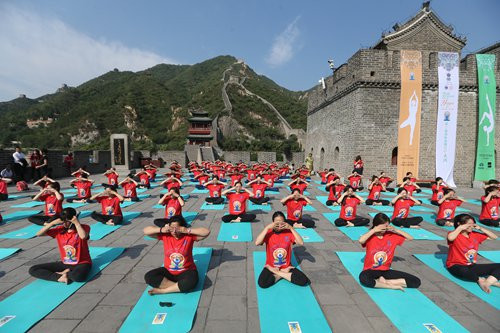
Yoga enthusiasts gather at Beijing's Great Wall on Tuesday to celebrate the International Day of Yoga. (Photo: Cui Meng/GT)
After watching her 55-year-old mother suffer in bed from a herniated disc for almost two years, 31-year-old Cao Mei decided to begin practicing yoga.
"I don't want to have the same condition when I reach her age," Cao told the Global Times.
After three years, she already started to see some benefits from yoga. She felt much stronger and people around her constantly complemented her figure.
Just like Cao, Chinese across the nation have begun turning to yoga to stay healthy. With the rising popularity of the practice, numerous yoga studios keep popping up across the country.
It doesn't stop there.
Just two weeks ago, Yunnan Minzu University also established its India China Yoga College, which will enroll undergraduate and graduate students majoring in yoga.
Since the United Nations proclaimed June 21 as the International Day of Yoga in 2014, many cities in China have started hosting international yoga festivals. The festivals in Chengdu, capital of Southwest China's Sichuan Province and Wuxi in East China's Jiangsu Province are just two examples.
In addition to large-scale yoga festivals, smaller events are also held in different residential communities, parks and also online across the nation.
On Tuesday, for example, hundreds of yoga enthusiasts from India and China gathered on the Great Wall in Beijing to celebrate the International Day of Yoga.
It certainly seems China's enthusiasm for yoga isn't going to cool down anytime soon.
Different preferences
Puspandra Kumar from India has been teaching yoga in China since 2006. With his experiences teaching in both in India and China, he has noticed many differences when it comes to how yoga is practiced in the two countries.
"[In India], they focus on meditation and pranayama [breathing exercises], but in China they just focus on asana, physical exercise, most of the time," Kumar told the Global Times on Monday.
Chinese students tend to choose different styles of yoga as well.
"Here [in China] there is Hot Yoga and Ashtanga Yoga. They like them much. Indian people don't like Hot Yoga. Very few people do Hot Yoga, because of the temperature," Kumar said.
Locations where practice takes place tend to be different as well, since Indian people tend to practice yoga outside in the mornings whereas most Chinese practice inside gyms and studios.
Chinese yoga instructor Chang Jinghan echoed Kumar's opinion. A yoga instructor since 2008, Chang studied yoga in India for a time.
"They [Indians] start practicing yoga at a very young age, so their bodies are much more flexible. But here in China, people start at an older age, so they should pay more attention to safety," Chang said.
Chang said that since she began yoga, her health has improved and she has become more outgoing.
"I gradually found it easier to interact with others, to talk to people," she said.
Most students the Global Times talked to said they felt much stronger and healthier after starting yoga and think it is the ideal way to get the body moving after a day of sedentary office work.
Like many athletic activities, yoga comes with some risk. As its popularity has risen, so too has the number of yoga-related injuries.
Instructor Zheng Qinghua said he heard that many people suffer from hip issues or other problems after practicing yoga.
"Many people tend to aim for a difficult yoga posture in a short time rather than slowly learn yoga," he said.
He explained that many Indians spend a very long time in basic training and gradually work up to very hard postures.
"I hope students could stop trying to jump to very hard postures right away just because they paid a lot of money and are trying to get their money's worth. Otherwise, they will just end up hurting themselves. "
New opportunities
Kumar came to China to teach yoga because he was told there were more opportunities here. That certainly seems to be the case as more studios in China are hiring foreign instructors from India and other countries and regions.
"Actually we have very strict rules when it comes to hiring foreign instructors," Lü Shanke, a salesperson with the Kamal Yoga Studio, told the Global Times on Monday.
"Because those instructors' classes will represent all yoga, we want them to be exemplary. This is why we have high requirements when it comes to personal training level and teaching level," Lu said.
Classes led by foreign instructor tend to be very popular, despite language barriers. Lu said that he believes these classes are ideal for those who already have years of experience practicing yoga, since the class content tends to be much more difficult and advanced.
Flying high
Not all yoga requires that you stay rooted on the ground.
"It's getting more popular. More yoga studios, gyms and dance studios have started to have aerial yoga classes," Li Siyi, founder of Skyline Dance Lab, which focuses on aerial exercise classes, told the Global Times on Monday.
Aerial yoga, or anti-gravity yoga, combines traditional yoga poses and acrobatic dance. Using a hammock that hangs from the ceiling, people can practice a number of poses without ever having to touch the ground.
"It can stretch and strengthen muscles far better than traditional yoga With the help of the hammock, many advanced yoga poses can also be accomplished, such as standing upside-down," Li said.
This new type of a yoga is rapidly gaining popularity in cities like Beijing and Shanghai.
Li noticed a spike in the number of students signing up for these classes recently. Those who take classes such as pole dancing or jazz dance at her lab also tend to study aerial yoga, as it helps strengthen muscles and is great fun when combined with dance moves.


















































